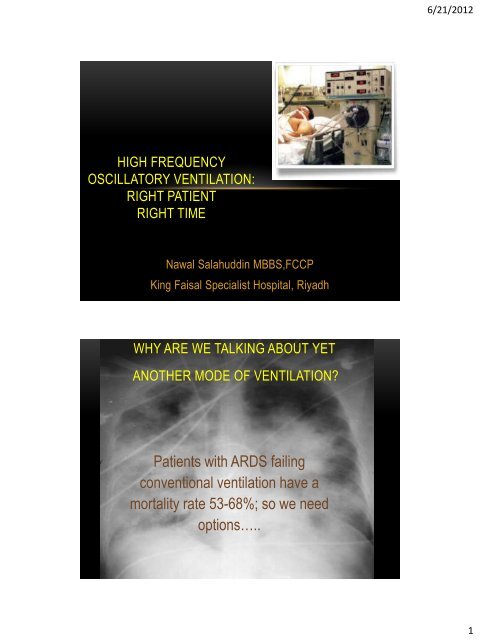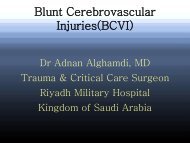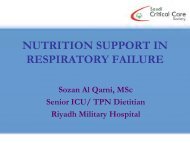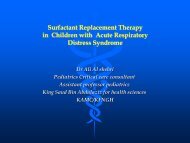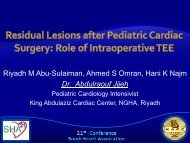021003 - RM Solutions
021003 - RM Solutions
021003 - RM Solutions
Create successful ePaper yourself
Turn your PDF publications into a flip-book with our unique Google optimized e-Paper software.
6/21/2012HIGH FREQUENCYOSCILLATORY VENTILATION:RIGHT PATIENTRIGHT TIMENawal Salahuddin MBBS,FCCPKing Faisal Specialist Hospital, RiyadhWHY ARE WE TALKING ABOUT YETANOTHER MODE OF VENTILATION?Patients with ARDS failingconventional ventilation have amortality rate 53-68%; so we needoptions…..1
6/21/2012BUT WHY IS HFOVAN OPTION?• How it works & Why it may be better than otherrescue modes• How does it perform in actual practice2
6/21/2012Unique that Inspiration &Expiration are active processesOscillating pumpBias flow of gasresistance valveVentilationamplitude (ΔP) , frequencyOxygenationFiO 2 & mPAW• Delivers smaller V T s ( 1-3 ml/kg), high respiratory rates (180 – 600brths/min)• Higher mPAW, maintained during inspiration & expiration3
6/21/2012Gas Exchange mechanismsTurbulent flow&radial mixingDirect Ventilationof close alveoliAsymmetric velocityprofilesPendelluftCardiogenicmixingDiffusionCollateralventilation4
6/21/2012Muellenbach et al. BMC Anesthesiology 2006 6:8PRESSURE DAMPENINGHFOVAttenuationof thepressures asair movestoward thealveolar levelGerstmann D.Pressuresexerted by theventilatorpropagatethrough theairway with littledampening5
6/21/2012WHAT MAKES HFOV AN ATTRACTIVE VENTILATIONSTRATEGY?• Small pressure swings allow forhigher mPAWs without injuriouslevels of PIP• Higher mPAWs means betterlung recruitment and a higherend-expiratory lung volumeHFOVINJURY• Combined effects of highmPAWs and v small pressureswings leads to less cyclicalrecruitment-derecruitmentINJURYCMV6
6/21/2012PROOF?Compared to Conventional ventilation:• reduced lung expression of inflammatory cytokines –IL-1β, IL-6, IL-8, IL-10, TGF, adhesion molecules, mRNA• reduced pathological injury - less hyaline membrane formation, lessalveolar leukocyte infiltration and less airway epithelial damageImai Y, Kawano T Am J Respir Crit CareMed 1994, 150:1550-15547
6/21/2012PRACTICAL MANAGEMENT• Start with Recruitment Maneuver(Increase mPAW to 45 cm H2Om maintain for 45 sec then reduce to 34)INITIAL SETTINGS:Ferguson,Kacmarek. CRIT CARE MED 2007;35,7;1649-1654• FiO2 1.0• mPAW (3-5 cm above CV or 34)• Δ P 90 cm H20 or titrated to producea’wiggle’ from shoulders to mid thigh• Bias flow 40 L/min• Frequency 5 Hz (3 -15)• % Inspiratory time 33%• Ventilation during HFOV should ideally occur in the ‘safe zone’ of thepressure–volume curve, avoiding both end- expiratory derecruitment andinspiratory overdistension• assessment of optimal lung recruitment by CXR & oxygenation8
6/21/2012mPAWOPTIMIZING OXYGENATIONmPAW23 35337.5Optimizing Ventilation (CO2 exchange)OPTIMIZING VENTILATION (CO2 EXCHANGE)• minimally deflating the cuffof the ET tube mayimprove ventilation• Monitor for a loss in P awwith the airleak9
6/21/2012Optimizing ventilation & OxygenationHIgherAmplitudeLower CO2Higher Frequency Higher CO2Higher mPAW betteroxygenationIS THERE CLINICAL DATA TO SUPPORT THE USE OFHFOV IN ADULTS?• 6 observational studies, all with severe ARDS (P/F ratios
6/21/2012Table 2—Patient Outcomes Using HFOV*OutcomesValuesDuration of HFOV, d 5.1 6.3Pneumothorax during HFOV 34 (21.8)Reason for withdrawal of HFOVSuccessfully weaned 76 (48.7)Withdrawal of life support/death 38 (24.4)Technical problem 5 (3.2)Oxygenation difficulty 12 (7.7)Ventilation difficulty 23 (14.7)Hemodynamic instability 8 (5.1)Other therapiesINO 68 (43.6)Steroids 58 (37.2)Prone positioning 10 (6.4)HFJV 5 (3.2)ECMO 2 (1.2)Outcome at 30 dDied 95 (61.7)AliveNo ventilatory support 28 (18.2)Ventilated 31 (20.1)• 156 patients• HFOV was used as rescue therapy for ARDS• APACHE II 24, OI 31, mortality 61.7%• Predictors of poor outcome on multivariable analysis:• older age, higher APACHE II score, lower pH• greater number of CV days prior to HFOV• OI at 24 hours*Values given as means SD or No. (%). HFJV high-frequencyjet ventilation; ECMO extracorporeal membrane oxygenation.Mehta.Chest 2004;126:518–27eart rate (top, A), andver the duration of thering CV immediatelyequent measurementse 0 represents valuesn. Values are given ast to each data pointvalues for trends inlic BP, p 0.03; heart0.004.number of CV days prior to starting HFOV therapy(p 0.0115); and baseline pH (p 0.0083). Stepwiselogistic regression identified OI as the mostsignificant posttreatment predictor of mortality andOI at 24 h as the most significant time point(p 0.0066). The relationship between predictedmortality and OI at 24 h, controlling for baselineconditions, is shown in Figure 4.We identified an OI of 15 at 24 h or animprovement of at least 30% in the OI at 24 h asthe best dichotomous criteria for survival (sensitivity,0.63; specificity, 0.67; p 0.007).• 8 RCTs, 419 patientsBMJ 2010;340:c2327ter the initiation ofand nonsurvivors.and nonsurvivorshown). Pao 2 /Fio 2ower in survivorsely). Fio 2 could beHFOV therapy inired lower Fio 20.0001). Thereen the two groups.Discussion• HFOV v/s CMV as initial ventilation strategyThe purpose of the current study was to summarizethe experience with HFOV therapy in threeToronto medical/surgical ICUs. We observed the• following. Median First, PaO2/FiO2 HFOV isratio used 112 as rescue therapy inadults with ARDS due to a wide variety of etiologies,when patients are already requiring high Fio 2 and/orhigh airway pressures. Second, the use of HFOV isassociated with improvements in ventilation andoxygenation, the latter permitting significant reductionsin delivered Fio 2 . Third, 26% of patients hadHFOV therapy discontinued due to difficulties with11
6/21/201230 day MORTALITY (RR 0.77,0.61-0.98, p 0.03)12
6/21/2012SO WHAT’S THE BOTTOM LINE?• Though the metanalysis showed a mortality benefit, in most of thestudies the CMV arm was not given lung protective ventilation• HFOV is;• As SAFE• IMPROVES oxygenation• MIGHT improve Survivalawait results of OSCAR and OSCILLATE trials13
6/21/2012CLINICAL APPLICATION OF HFOV IN ADULTSConsider as a Rescue therapy for patients with ARDS failingconventional ventilation• Oxygenation Failure (FiO2 > 0.7 andPEEP 14 with PIP > 35)• Ventilation failure (PH < 7.25 despite V T 6ml/kg or Pplateau > 30)Adebayo Esan, Dean R. Hess, Suhail Raoof, Severe Hypoxemic RespiratoryFailure : Part 1 Ventilatory Strategies Chest 2010;137;1203-1216CLINICAL APPLICATION OF HFOV IN ADULTS• Earlier is Better; each extra day on CMV prior to HFOV increasedmortality by 20%• Extra pulmonary ARDS may benefit morePachl J, Roubik K, Waldauf P, et al. Normocapnic high-frequency oscillatoryventilation affects differ- ently extrapulmonary and pulmonary forms of acuterespiratory distress syndrome in adults. Physiol Res 2006;55:15–24• Predictors of mortality on HFOV; oxygenation index post-txBollen CW, Uiterwaal CS, van Vught AJ. Systematic review of determinants ofmortality in high frequency oscillatory ventilation in acute respiratory distresssyndrome. Crit Care 2006;10:R3414
6/21/2012CLINICAL APPLICATION OF HFOV IN ADULTS• Not effective in all patients with ARDS; 26% failure rateMehta S, Granton J, MacDonald RJ, et al. High- frequency oscillatory ventilation in adults: theToronto experience. Chest 2004;126:518–27• Not indicated in• isolated hypercapneic respiratory failure,• severe airway obstruction,• increased ICPOTHER USES OF HFOVTraumatic brain injury & ARDSYoung N.HFOV as a rescue strategy for Brain injured with ALI/ARDS.NeuroCrit Care2011;15:623-633David, M. et al., 2005. High-frequency oscillatory ventilation in adults with traumatic brain injuryand acute respiratory distress syndrome. Acta Anaesthesiologica Scandinavica, 49(2), p.209-214Bronchopleural fistulae and PneumatocelesManagement of advanced ARDS complicated by bilateral pneumothoraces with highfrequencyoscillatory ventilation in an adult. Br J Anaesth September 2004 93:3 454-456Baumann, MH, Sahn, SA Medical management and therapy of bronchopleuralfistulas in the mechanically ventilated patient. Chest 1990;97,721-72815
6/21/2012IN CONCLUSION……• HFOV can provide the highest constant mPAW coupled with the lowestV T of any mode. This makes it the ideal Lung Protective mode• HFOV should be considered in patients with oxygenation failurerefractory to conventional ventilation• Early use in patients with severe ARDS (OI > 30) may have a mortalitybenefit• Practical use of HFOV may be challenging; with risks of barotrauma, ETtube occlusion and prolonged sedation and paralysis16


